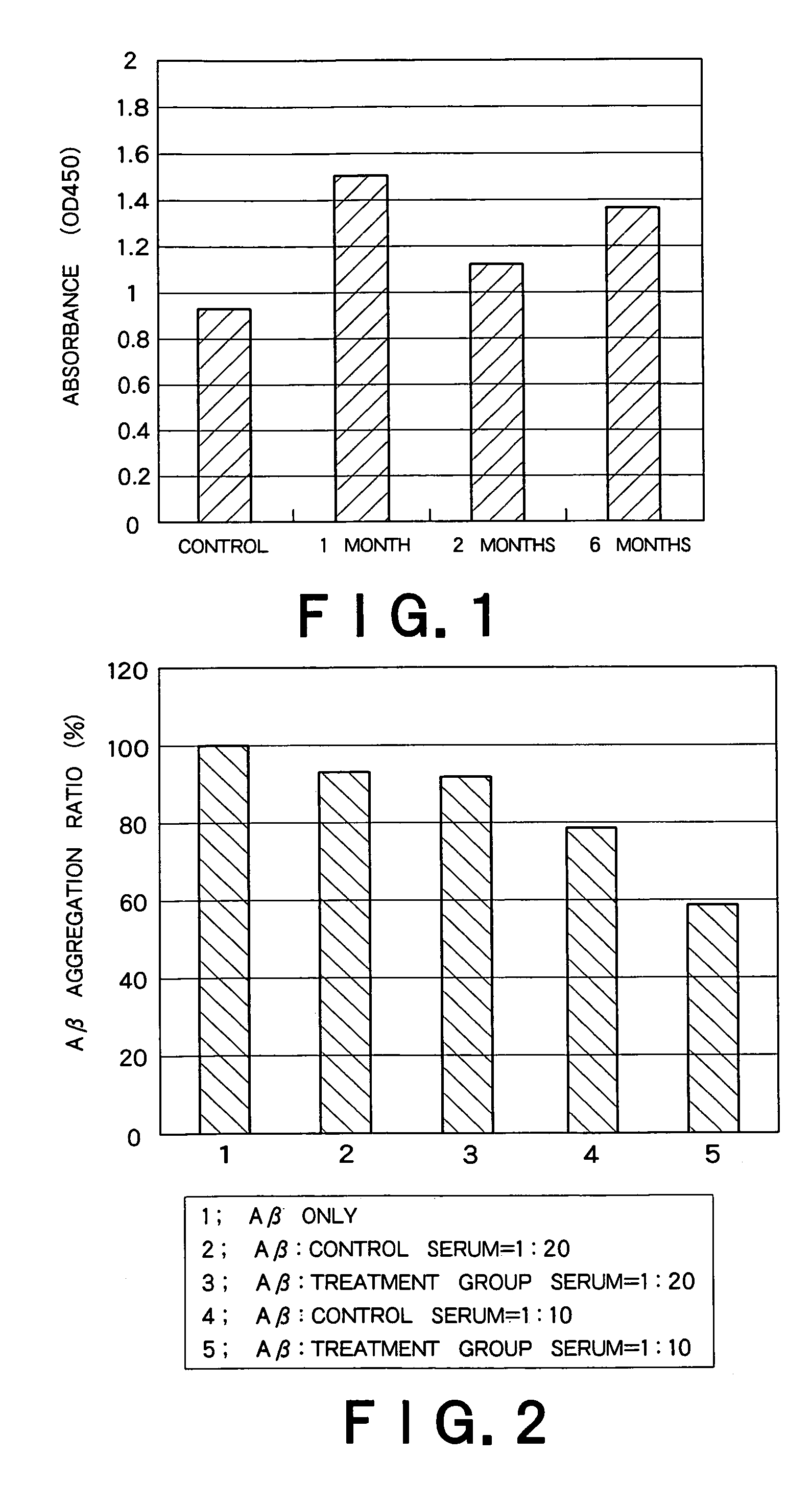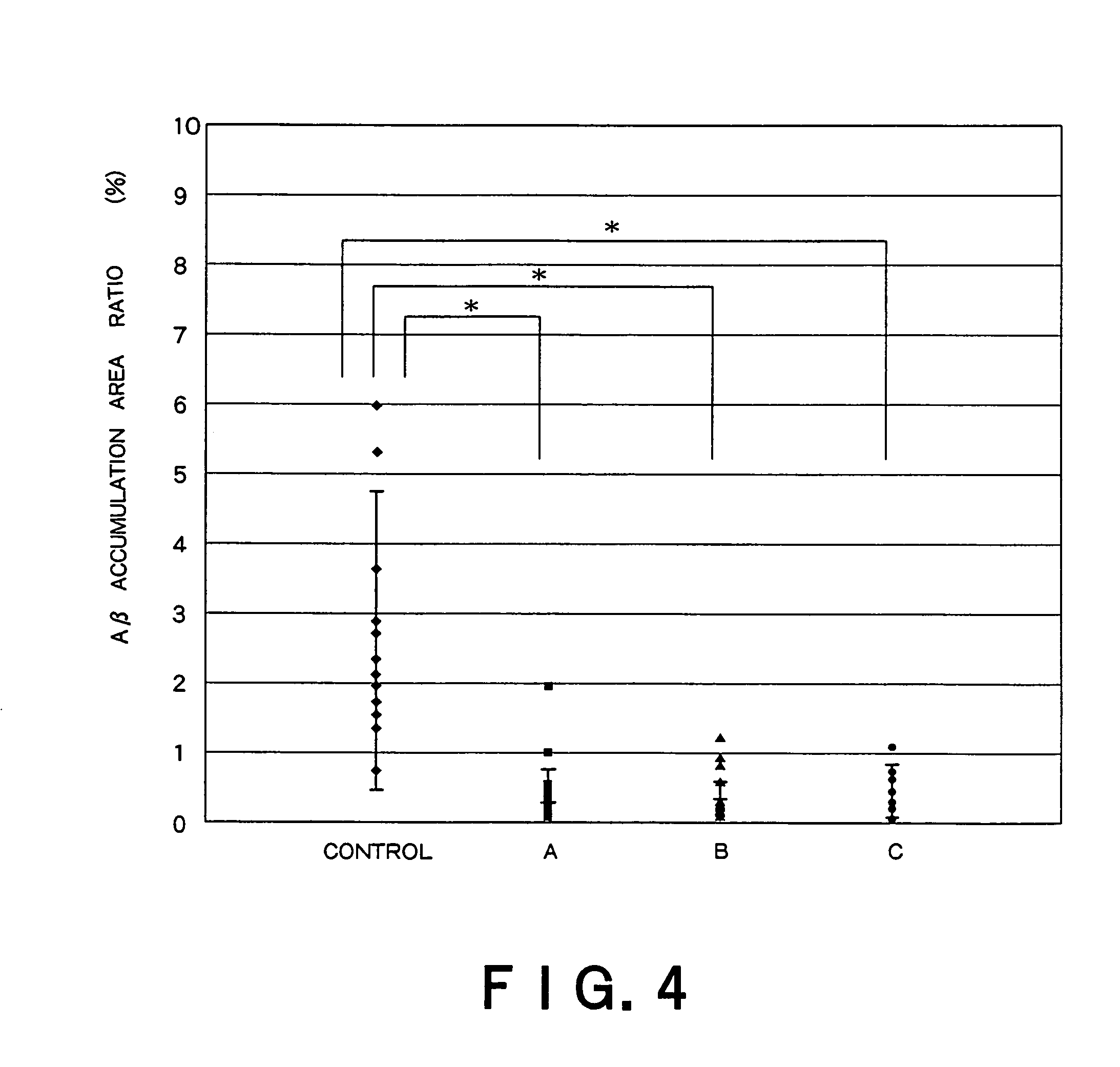Recombinant adeno-associated virus vector for treatment of Alzheimer disease
a technology of adeno-associated virus and alzheimer's disease, which is applied in the field of adeno-associated virus vectors expressing a peptides, can solve the problems of inability to meet the requirements of a antigen use in animals, no in vivo experiment reported, and no therapeutic agent to meet the requirements of a antigen use, etc., to achieve high-quality and safe treatment of alzheimer's disease. ,
- Summary
- Abstract
- Description
- Claims
- Application Information
AI Technical Summary
Benefits of technology
Problems solved by technology
Method used
Image
Examples
example 1
Construction of Adeno-Associated Virus Vector Expressing APP Signal Sequence+Aβ1-43 cDNA
[0042]Amyloid-β1-43 (Aβ1-43) cDNA was amplified by PCR using the human amyloid precursor protein (APP) gene as a template and the following primers. The PCR reaction solution contained TAPS buffer (25 mM, pH 9.3), KCl (50 mM), MgCl2 (2 mM), 2-mercaptoethanol (1 mM), dNTPs (100 μM), template DNA (50-100 ng), and primers (0.2 μM each). The PCR thermal reaction was performed for 30 cycles, each cycle consisting of 30 seconds at 94° C., 1 minute at 68° C., and 3 minutes at 72° C.
Primers
[0043]
Forward:5′-GATGCAGAATTCCGACATGACTCAGGA-3,′(SEQ ID NO: 11)andReverse:5′-GTCTTAAGTCGCTATGACAACACCGCCC-3′(SEQ ID NO: 12having an AflII site at the 3′ end)
[0044]The adaptor for APP secretion signal, first signal sequence at the N terminus (SEQ ID NO: 10), was constructed by treating the following two oligonucleotides for 3 minutes at 90° C. followed by annealing at room temperature.
Oligonucleotides
[0045]
Sense:(SEQ ID...
example 2
Construction of Adeno-Associated Virus Vector Expressing APP Signal Sequence+Aβ1-21 cDNA
[0050]APP signal sequence+Aβ1-43 cDNA (XbaI-AflII / blunt) was ligated into the pBluescript plasmid (XbaI-SmaI). PCR was performed using this as a template and the following primers.
Primers
[0051]
Forward:5′-TGGCGGCCGCTCTAGAATG-3′(SEQ ID NO: 16,having a NotI site at the 5′ end)Reverse:5′-CACATCTTAAGCAAAGAACACC-3′(SEQ ID NO: 17)
[0052]PCR products of the APP signal sequence+Aβ1-21 cDNA (SEQ ID NO: 9 having a NotI restriction site at nucleotides 3-10 and an XbaI restriction site at nucleotides 11-16 in this sequence) were subjected to the NotI-AflII / blunt treatment and the resulting products were ligated into pXXUF1 (NotI-SalI) together with the abovementioned “stuffer” pBR322 PvuII-SalI fragment.
[0053]Further, in the same manner as in Example 1, the adeno-associated virus vector having the APP signal sequence+Aβ1-21 cDNA was obtained.
PUM
| Property | Measurement | Unit |
|---|---|---|
| temperature | aaaaa | aaaaa |
| pH | aaaaa | aaaaa |
| concentration | aaaaa | aaaaa |
Abstract
Description
Claims
Application Information
 Login to View More
Login to View More - R&D
- Intellectual Property
- Life Sciences
- Materials
- Tech Scout
- Unparalleled Data Quality
- Higher Quality Content
- 60% Fewer Hallucinations
Browse by: Latest US Patents, China's latest patents, Technical Efficacy Thesaurus, Application Domain, Technology Topic, Popular Technical Reports.
© 2025 PatSnap. All rights reserved.Legal|Privacy policy|Modern Slavery Act Transparency Statement|Sitemap|About US| Contact US: help@patsnap.com



